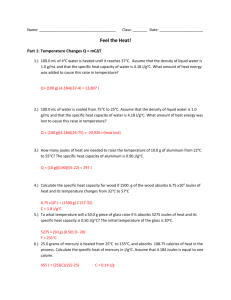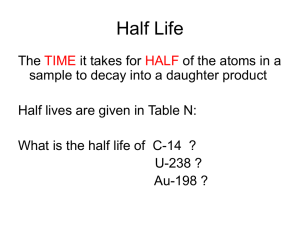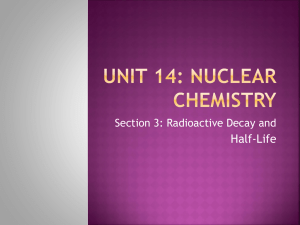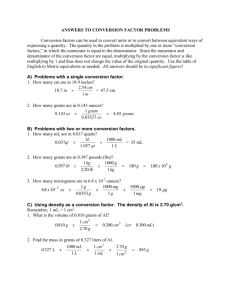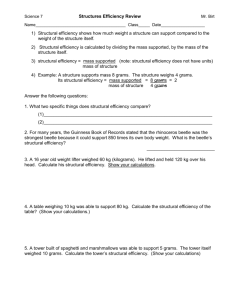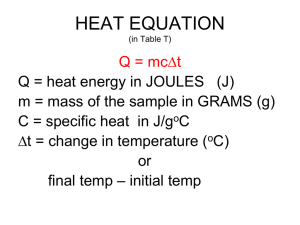Heat Change - BrakkeIBchem2
advertisement
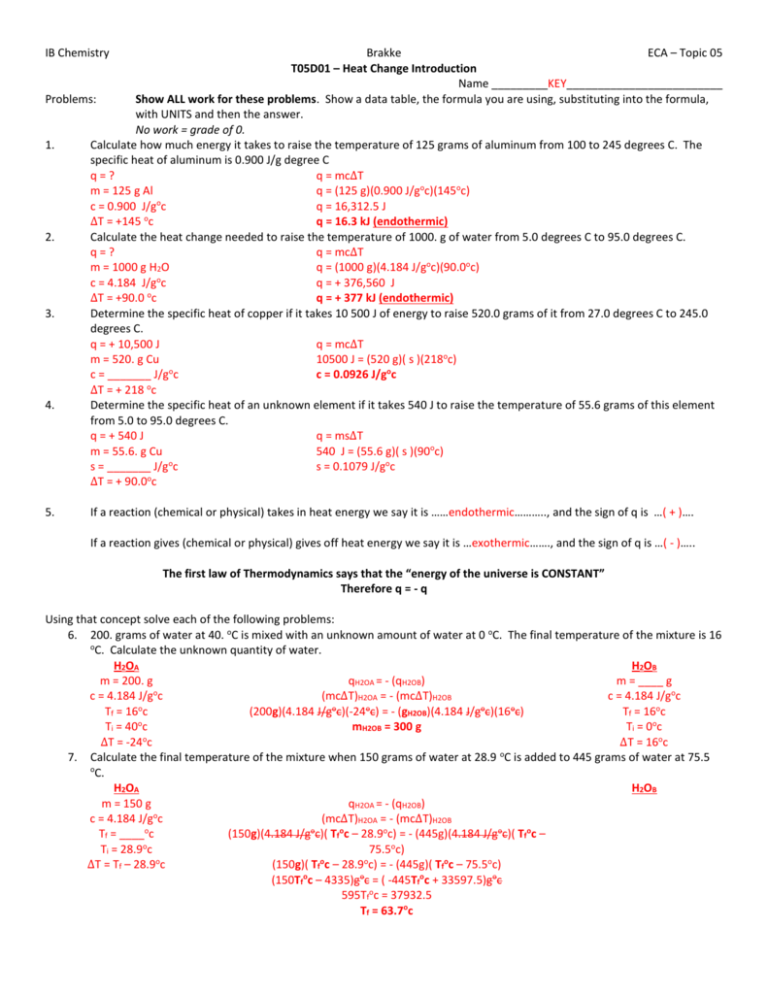
IB Chemistry Brakke ECA – Topic 05 T05D01 – Heat Change Introduction Name _________KEY_________________________ Problems: Show ALL work for these problems. Show a data table, the formula you are using, substituting into the formula, with UNITS and then the answer. No work = grade of 0. 1. Calculate how much energy it takes to raise the temperature of 125 grams of aluminum from 100 to 245 degrees C. The specific heat of aluminum is 0.900 J/g degree C q=? q = mcΔT m = 125 g Al q = (125 g)(0.900 J/goc)(145oc) c = 0.900 J/goc q = 16,312.5 J ΔT = +145 oc q = 16.3 kJ (endothermic) 2. Calculate the heat change needed to raise the temperature of 1000. g of water from 5.0 degrees C to 95.0 degrees C. q=? q = mcΔT m = 1000 g H2O q = (1000 g)(4.184 J/goc)(90.0oc) o c = 4.184 J/g c q = + 376,560 J ΔT = +90.0 oc q = + 377 kJ (endothermic) 3. Determine the specific heat of copper if it takes 10 500 J of energy to raise 520.0 grams of it from 27.0 degrees C to 245.0 degrees C. q = + 10,500 J q = mcΔT m = 520. g Cu 10500 J = (520 g)( s )(218oc) o c = _______ J/g c c = 0.0926 J/goc o ΔT = + 218 c 4. Determine the specific heat of an unknown element if it takes 540 J to raise the temperature of 55.6 grams of this element from 5.0 to 95.0 degrees C. q = + 540 J q = msΔT m = 55.6. g Cu 540 J = (55.6 g)( s )(90oc) o s = _______ J/g c s = 0.1079 J/goc o ΔT = + 90.0 c 5. If a reaction (chemical or physical) takes in heat energy we say it is ……endothermic……….., and the sign of q is …( + )…. If a reaction gives (chemical or physical) gives off heat energy we say it is …exothermic……., and the sign of q is …( - )….. The first law of Thermodynamics says that the “energy of the universe is CONSTANT” Therefore q = - q Using that concept solve each of the following problems: 6. 200. grams of water at 40. oC is mixed with an unknown amount of water at 0 oC. The final temperature of the mixture is 16 o C. Calculate the unknown quantity of water. H2OA H2OB m = 200. g qH2OA = - (qH2OB) m = ____ g c = 4.184 J/goc (mcΔT)H2OA = - (mcΔT)H2OB c = 4.184 J/goc o o o o o Tf = 16 c (200g)(4.184 J/g c)(-24 c) = - (gH2OB)(4.184 J/g c)(16 c) Tf = 16oc o Ti = 40 c mH2OB = 300 g Ti = 0oc o ΔT = -24 c ΔT = 16oc o 7. Calculate the final temperature of the mixture when 150 grams of water at 28.9 C is added to 445 grams of water at 75.5 o C. H2OA H2OB m = 150 g qH2OA = - (qH2OB) c = 4.184 J/goc (mcΔT)H2OA = - (mcΔT)H2OB o o Tf = ____ c (150g)(4.184 J/g c)( Tfoc – 28.9oc) = - (445g)(4.184 J/goc)( Tfoc – o Ti = 28.9 c 75.5oc) o o o ΔT = Tf – 28.9 c (150g)( Tf c – 28.9 c) = - (445g)( Tfoc – 75.5oc) (150Tfoc – 4335)goc = ( -445Tfoc + 33597.5)goc 595Tfoc = 37932.5 Tf = 63.7oc IB Chemistry Brakke ECA – Topic 05 8. Calculate the initial temperature of a 55.5 grams piece of nickel that when placed into 100. grams of water at an initial temperature of 22.5 oC results in a mixture temperature of 27.4 oC [Specific Heat of Ni = 0.440 J/goc) Ni H2OB m = 55.5 g qNi = - (qH2OB) m = 100. g c = 0.440 J/goc (mcΔT)Ni = - (mcΔT)H2OB c = 4.184 J/goc o o o o o Tf = 27.4 c (55.5g)(0.440 J/g c)(27.4 c-Ti Ni) = - (100.g)(4.184 J/g c)( 4.9 c) Tf = 27.4oc Ti = ____oc (24.4J/oc)(27.4oc-Ti Ni) = -2050 J Ti = 22.5oc ΔT = 27.4oc – 28.9oc (27.4oc-Ti Ni) = -84.0 oc ΔT = 4.9oc o Ti Ni = 111 c 9. When 1.34 grams of potassium bromide (KBr) dissolves in 74.0 grams of water in a coffee-cup calorimeter, the temperature drops from 291.0 K to 290.3 K. Assume all heat absorbed in the solution process comes from the water. a. Write a balanced equation for the solution process. KBr (s) + H2O (l) K+ (aq) + Br- (aq) + H2O OR KBr (s) K+ (aq) + Br- (aq) b. What is q of the water? Cannot find q of KBr directly so must find it for H2O and use q = -q for part (c). qH2O = mcΔT qH2O = (74.0 g)( 4.184 J/goc)( - 0.7oc) = - 216 J mH2O = 74.0 g cH2O = 4.184 J/goc ΔTH2O = 290.3-291.0 = - 0.7 K = - 0.7oc c. What is q when potassium bromide dissolves? qBr = -(qH2O) qBr = -(-216J) qBr = +216J d. Is the process endothermic or exothermic? Explain. q for the salt is positive (+) and therefore energy is taken in from the surroundings (water) making the heat change for KBr endothermic e. What is the molar heat of solution if 1.34 grams of KBr were dissolved? n (KBr) = qmol = 𝑚 𝑀𝑟 217 0.0113 = 1.34 119 = 0.0113 = 19200𝐽 = 19.2 𝑘𝐽 ΔH f. Draw an energy diagram for this reaction K+ (aq) + Br- (aq) Enthalpy ΔH = 19.2 𝐾𝐽/𝑚𝑜𝑙 Enthalpy KBr (s) g. Level 5: Calculate the energy change (∆H) when 10.00 moles of potassium bromide dissolves in sufficient water. 19.2 𝑘𝐽 10 𝑚𝑜𝑙 𝐾𝐵𝑟 𝑥 = ΔH = 192 kJ 𝑚𝑜𝑙 𝐾𝐵𝑟 h. Level 6: Calculate the energy change (∆H) when 10.00 grams of potassium bromide dissolves in sufficient water. 10.00 𝑔𝐾𝐵𝑟 𝑥 1𝑚𝑜𝑙 𝐾𝐵𝑟 119 𝑔 𝐾𝐵𝑟 𝑥 19.2 𝑘𝐽 1 𝑚𝑜𝑙 𝐾𝐵𝑟 = ΔH = 1.61 kJ

